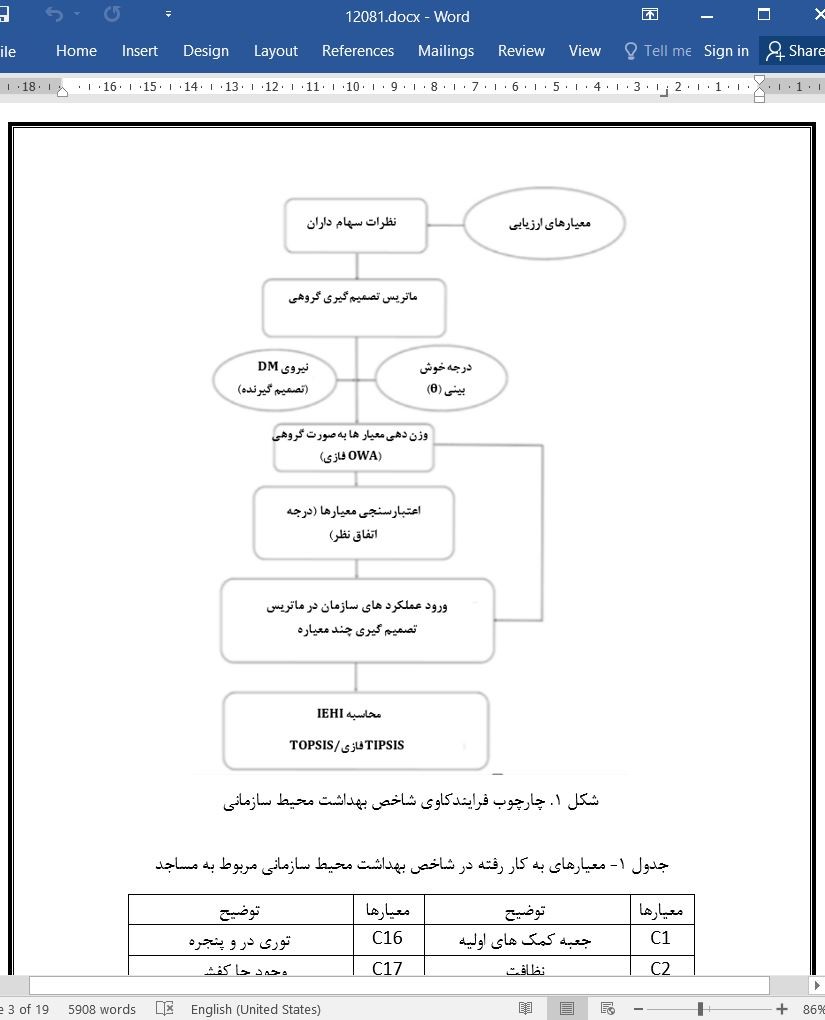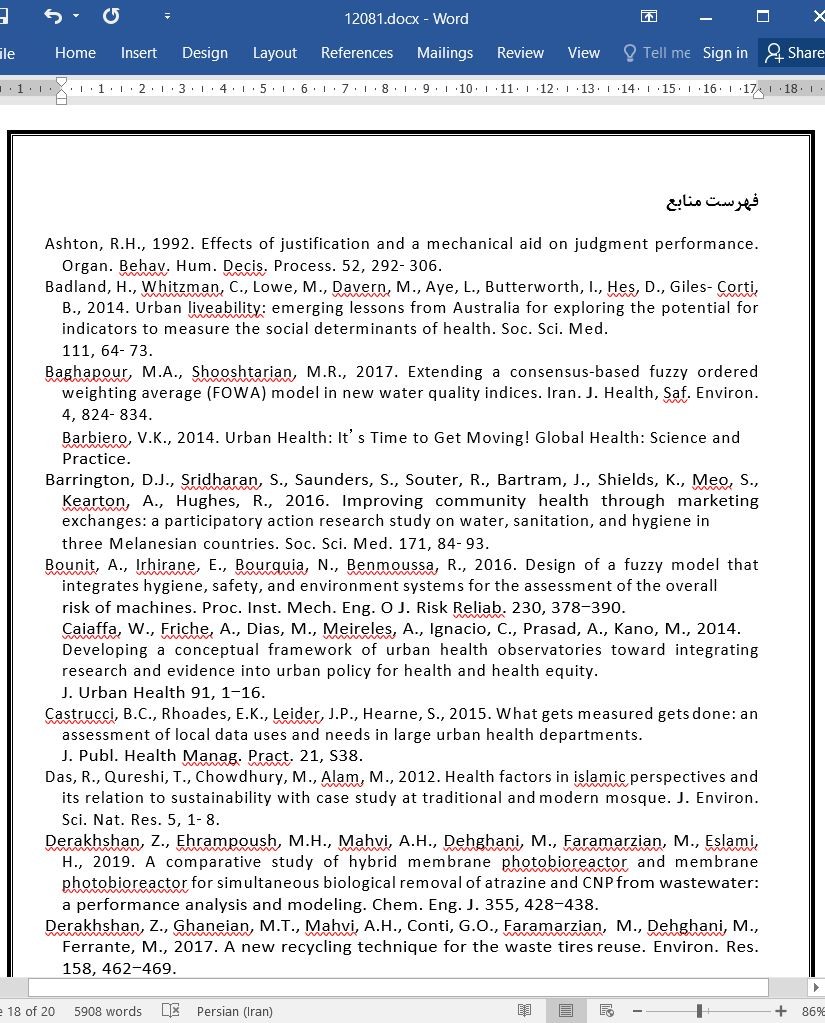
رویکرد فرآیندکاوی در آنالیز داده های مهم و مدل سازی ریسک های تصمیم گیری
چکیده
این مقاله قصد دارد به معرفی یک چارچوب فرایندکاوی با هدف سنجش وضعیت بهداشت محیط در سازمان ها بپردازد. این رویکرد، یک شاخص مبتنی بر نرم افزار بنام شاخص بهداشت محیط سازمانی (IEHI) را ایجاد کرده است که حاصل تلفیق مدل های تصمیم گیری گروهی چند معیاره مبتنی بر هستی شناسی بوده که این مدل ها بر پایه اصول مدل سازی فازی و برآورد اتفاق نظر همگانی می باشند. میانگین وزنی مرتب شده فازی (OWA) با قابلیت مدل سازی عدم اطمینان ها و ریسک های تصمیم گیری به همراه تکنیک اولویت بندی بر اساس شباهت به راه حل ایده آل (TOPSIS) بعنوان موتور های محاسباتی به کار گرفته شدند. عملکرد این شاخص توسعه یافته طی یک مثال کاربردی در 20 مسجد به عنوان نهادهای عمومی مورد آزمایش قرار گرفت. شاخص بهداشت محیط سازمانی توانست داده های مهم جمع آوری شده توسط محققین را بررسی کرده و آنها را به یک عدد واحد و قابل تفسیر تبدیل کند. این شاخص مساجدی را با شرایط بهداشتی بسیار نامناسب شناسایی کرد که می بایست به لحاظ برخورداری از بهداشت و همچنین شرایط مناسب، در اولویت باشند. این شاخص با توجه به قابلیت تعریف نوع و اعداد معیارها و همچنین بهره مندی از یک نرم افزار خاص و کاربرپسند موسوم به تصمیم گیری فازی گروهی، بسیار انعطاف پذیر و کاربردی است. از این رویکرد می توان برای محاسبه شرایط بهداشت محیط در هر سازمان یا شغل مورد نظری استفاده کرد. شاخص پیشنهادی از طریق تجزیه و تحلیل داده ها و ریسک های مهمی که موجب اتخاذ تصمیمات واقع بینانه تری میشوند، می بایست بتواند ارزیابی کارآمدتری از بهداشت الکترونیکی داشته باشد.
1. مقدمه
شهرنشینی به مرور زمان و به ویژه در مناطقی با درآمد متوسط و کم مانند کشور های در حال توسعه با سرعت بیشتری صورت گرفته و در نتیجه کمبود بهداشت در این مکان ها بواسطه سود کمتر و اقتصاد ضعیف، شدت بیشتری پیدا می کند. از دهه 1940 تا کنون، هم بستگی بین محیط فیزیکی (اشاره به ساختمان ها و مکان های عمومی) و بهداشت انسان، یکی از اولویت های سازمان بهداشت جهانی (WHO) محسوب می شود. مطالعات نشان داده اند که بهداشت محیط در یک شهر بزرگ، اقتصاد را نیز مانند سیاست تحت تاثیر قرار داده و این یک معیار جامع در برنامه ریزی و تصمیم گیری شهری محسوب می شود؛ از این رو انتظار می رود پوشش بهداشت تا حد زیادی در این جوامع مشاهده شود.
4. نتیجه گیری
در سیستم های مراقبت بهداشتی، به دلیل وجود محدودیت های اقتصادی، بهبود همزمان شرایط بهداشتی در مکان های عمومی غالبا غیر ممکن بوده و انجام این فرایند طی چند مرحله برای مدیران، عقلانی تر است. در اولین گام باید با انجام یک ارزیابی جامع، مکان هایی که دارای کمترین سطح بهداشت هستند را شناسایی کرده و سپس باید آن ها را در جهت بهینه سازی و اصلاح شرایط، اولویت بندی کرد. این مطالعه با هدف ارائه یک چارچوب فرایند کاوی یک شاخص عددی برای تجزیه و تحلیل داده ها و مدل سازی ریسک در ارزیابی بهداشت محیط مربوط به سازمان های شهری و مکان های عمومی، انجام شده است. شاخص توسعه یافته، نمایان گر آن است که برخی از مکان های مطالعه شده، شرایط بسیار نامناسبی داشته و باید آن ها از نظر بهداشتی در اولویت قرار داد. این شاخص، شاخصي مفید برای سنجش اوضاع بهداشت سازمانی بوده و نقاط ضعف و ریشه های مربوط به مشکلات بهداشتی آن ها را به خوبی کشف می کند.
Abstract
This paper aimed to introduce a process-mining framework for measuring the status of environmental health in institutions. The methodology developed a new software-based index namely Institutional Environmental Health Index (IEHI) that was integrated from ontology-based Multi-Criteria Group Decision-Making models based on the principles of fuzzy modeling and consensus evaluation. Fuzzy Ordered Weighting Average (OWA) with the capability of modeling the uncertainties and decision-making risks along with Technique for Order Preference by Similarity to Ideal Solution (TOPSIS) were employed as the computation engine. The performance of the extended index was examined through an applied example on 20 mosques as public institutions. IEHI could analyze big data collected by environmental health investigators and convert them to a single and interpretable number. The index detected the mosques with very unsuitable health conditions that should be in priority of sanitation and suitable ones as well. Due to the capability of defining the type and numbers of criteria and benefitting from specific and user-friendly software namely Group Fuzzy Decision-Making, this index is highly flexible and practical. The methodology could be used for numerating the environmental health conditions in any intended institution or occupation. The proposed index would provide e-health assessment by more efficient analysis of big data and risks that make more realistic decisions in environmental health system.
1. Introduction
Urbanization is becoming faster by passing the time specially, in medium and low income areas like developing countries and as a consequence the health deficiency is more sever in these locations due to lower earning and poor economy (Derakhshan et al., 2017; Mbuya and Humphrey, 2016; Verma et al., 2017). The correlation between physical environment, referring to buildings and public places, with human health has been one of the World Health Organization (WHO’s) priorities since 1940s (Ene, 2014). Studies showed that the environmental health in a big city influences the economy as well as policy and it is an integral criterion for city planning and decision-making. Hence, the hygiene coverage is expected to be highly observed in such communities (Jenkins et al., 2014; Weingaertner and Moberg, 2014; Wolch et al., 2014).
4. Conclusion
In health care systems, due to economical limitations, the simultaneous improvement of the health conditions in public places is often impossible and performing this process in multiple stages is more reasonable for the managers. In the first step, the places with the lowest sanitary level should be identified by doing a comprehensive assessment and then they should be prioritized for optimization and improvement. This study has aimed to present a process mining framework of a numerical index for data analyzing and risk modeling in environmental health assessment in urban institutions and public places. Developed index indicated that some of the studied places had very unsuitable conditions and they should be prioritized for sanitation. This index is a useful indicator to measure institutional health status and it detects the weak points and the origins of health problems of them well.
چکیده
1. مقدمه
2. اصول و رویکردها
1.2. محاسبه شاخص بهداشت محیط سازمانی
3. نتیجه و بحث
4. نتیجه گیری
اعلامیه مربوط به تضاد منافع
تشکر و قدردانی
فهرست منابع
Abstract
1. Introduction
2. Materials & methods
2.1. IEHI calculation
3. Result and discussion
4. Conclusion
Declaration of competing interest
Acknowledgment
Author contribution
References
- ترجمه فارسی مقاله با فرمت ورد (word) با قابلیت ویرایش، بدون آرم سایت ای ترجمه
- ترجمه فارسی مقاله با فرمت pdf، بدون آرم سایت ای ترجمه



